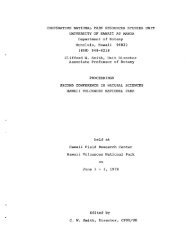american samoa - University of Hawaii at Manoa
american samoa - University of Hawaii at Manoa
american samoa - University of Hawaii at Manoa
You also want an ePaper? Increase the reach of your titles
YUMPU automatically turns print PDFs into web optimized ePapers that Google loves.
APPENDIX E. PLANTS AS INDICATORS OF PAST LAND USE<br />
Prior to the arrival <strong>of</strong> the first Polynesian settlers,<br />
most <strong>of</strong> the surface area <strong>of</strong> the Samoan archipelago<br />
was covered with n<strong>at</strong>ive rainforest veget<strong>at</strong>ion. The<br />
only areas with veget<strong>at</strong>ion not classified as rain-<br />
I'orcst were littoral communities, summit veget<strong>at</strong>ion<br />
(montane scrub and summit scrub communities),<br />
recent lava flows and ash deposits, and disturbed<br />
veget<strong>at</strong>ion. Nowadays over half <strong>of</strong> the veget<strong>at</strong>ion <strong>of</strong><br />
the islands is classified as disturbed or secondary (as<br />
opposed to primary), a figure th<strong>at</strong> has been rising in<br />
recent years because <strong>of</strong> the expansion <strong>of</strong> agriculture<br />
to meet the needs <strong>of</strong> an expanding popul<strong>at</strong>ion and<br />
because <strong>of</strong> a forestry industry th<strong>at</strong> has devast<strong>at</strong>ed the<br />
lowlands <strong>of</strong> the archipelago (particularly in Western<br />
Samoa). Prior to human settlement, all the disturbed<br />
veget<strong>at</strong>ion was n<strong>at</strong>ural, caused mostly by hurricanes<br />
and landslips, and possibly by occasional forest<br />
fires. Nowadays, however, most <strong>of</strong> the disturbed<br />
veget<strong>at</strong>ion is the result <strong>of</strong> human activities such as<br />
agriculture and the development <strong>of</strong> villages. The<br />
disturbed communities recognized in the present<br />
report are managed land veget<strong>at</strong>ion, secondary<br />
scrub, and secondary forest.<br />
It is sometimes useful to know the past uses <strong>of</strong> an<br />
area <strong>of</strong> land. In order to set lease prices within the<br />
park, there is a need to determine which areas are<br />
currently or were historically used for agriculture.<br />
This was done mainly by the use <strong>of</strong> aerial photo-<br />
graphs and the maps <strong>of</strong> Cole et al. (1988). More<br />
accur<strong>at</strong>e studies involve the structure and floristic<br />
composition <strong>of</strong> the veget<strong>at</strong>ion. N<strong>at</strong>ive Samoan plant<br />
species require certain environmental conditions for<br />
germin<strong>at</strong>ion and growth, and it is <strong>of</strong>ten possible to<br />
determine the recent historic uses <strong>of</strong> the area by<br />
analyzing the species composition, community<br />
structure, and popul<strong>at</strong>ion dynamics <strong>of</strong> an area <strong>of</strong><br />
veget<strong>at</strong>ion. This is most easily done by looking for<br />
indic<strong>at</strong>or species, plants th<strong>at</strong> are indic<strong>at</strong>ive <strong>of</strong> a<br />
certain type <strong>of</strong> human activity or clim<strong>at</strong>ic event.<br />
The most obvious sign <strong>of</strong> recent disturbance is the<br />
dominance <strong>of</strong> herbaceous veget<strong>at</strong>ion. The only kind<br />
<strong>of</strong> n<strong>at</strong>ural veget<strong>at</strong>ion in Samoa th<strong>at</strong> is herbaceous is<br />
in littoral areas (herbaceous strand) and montane<br />
scrub (which is characterized by ferns and climbers<br />
domin<strong>at</strong>ing the ground between sc<strong>at</strong>tered trees and<br />
shrubs). The most common species in the recently<br />
129<br />
disturbed areas, most <strong>of</strong> which are abandoned taro<br />
or banana plant<strong>at</strong>ions, are Mikania micrantha<br />
(mile-a-minute vine, fue saina), Bidens alba<br />
(beggar's-tick), Paspalum conjug<strong>at</strong>um (T-grass, vao<br />
ha), and Nephrolepis hirsutula (sword fern, vao<br />
tuaniu), but over 250 species th<strong>at</strong> fit into this<br />
c<strong>at</strong>egory (weeds) have been recorded from Tutuila<br />
(see Appendix A).<br />
Several other species planted as ornamentals<br />
sometimes remain significant long after cultiv<strong>at</strong>ion<br />
has ended. One such species, the mint Pogostemon<br />
cablin (p<strong>at</strong>chouli, p<strong>at</strong>iale), sometimes forms dense<br />
p<strong>at</strong>ches by veget<strong>at</strong>ive means; it has not been<br />
recorded from the Tutuila park, however. Other<br />
weedy species are typical <strong>of</strong> forest trails. Axonopus<br />
fissifolius and Eleusine indica (ta'<strong>at</strong>a'a) are <strong>of</strong>ten<br />
found in lowland plant<strong>at</strong>ions and along trails in<br />
lowland forest. Two other grasses, Oplismenus<br />
compositus and Oplismenus hirtellus, are <strong>of</strong>ten<br />
found in secondary forest and thus can be indic<strong>at</strong>ive<br />
<strong>of</strong> past disturbance. Another two grasses, Cento-<br />
steca lappacea (sefa) and Cyrtococcum oxyphyllum,<br />
occur in primary veget<strong>at</strong>ion, and are thus less<br />
valuable as indic<strong>at</strong>or species.<br />
One species <strong>of</strong> fern, Dicranopteris linearis (false<br />
staghorn fern, asaua), is a n<strong>at</strong>ural dominant species<br />
in montane scrub (which is usually on trachyte soil),<br />
but its presence in other places, such as ridges, is an<br />
indic<strong>at</strong>ion <strong>of</strong> past disturbance. There are only a few<br />
areas (outside <strong>of</strong> montane scrub) on Tutuila th<strong>at</strong> are<br />
reported to be domin<strong>at</strong>ed by this fern. These are<br />
probably areas <strong>of</strong> former plant<strong>at</strong>ions or villages on<br />
ridges, from a period when the bulk <strong>of</strong> the Samoan<br />
popul<strong>at</strong>ion lived inland (for protection from<br />
marauders and enemies). The soil has been so<br />
over-utilized and the soil minerals so depleted th<strong>at</strong><br />
the n<strong>at</strong>ive veget<strong>at</strong>ion (mostly ridge lowland forest)<br />
has never been able to recover. Similar veget<strong>at</strong>ion is<br />
found on 'Upolu, and is <strong>at</strong>tributed to the same cause<br />
(Wright 1963).<br />
When managed land is left alone for long enough,<br />
the herbaceous veget<strong>at</strong>ion is shaded out by a number<br />
<strong>of</strong> characteristic woody shrubs and trees. The most<br />
typical <strong>of</strong> these are Pipturus argenteus (soga),<br />
Omalanthus nutans (fogamamala), Macaranga
















